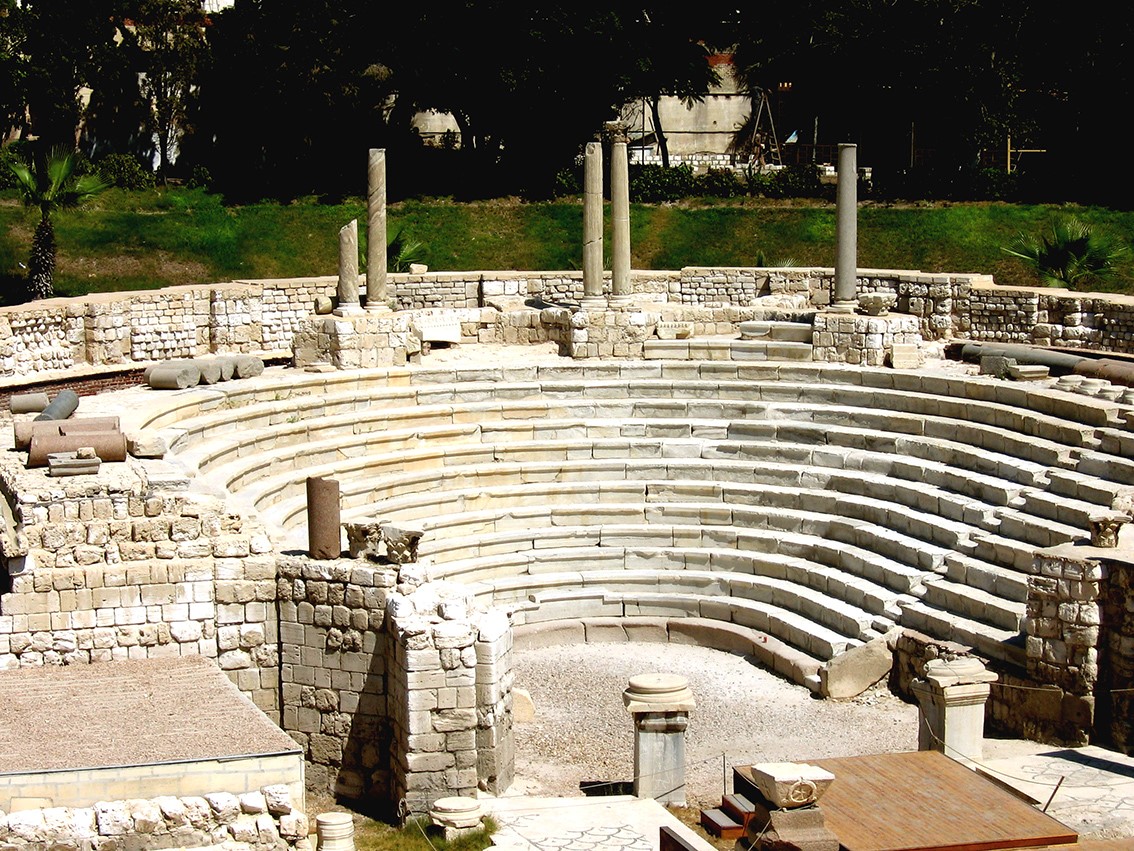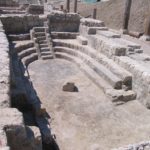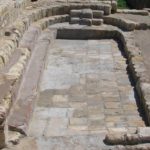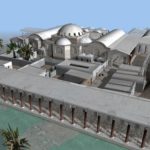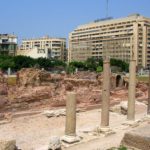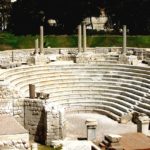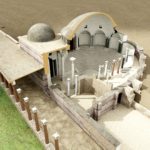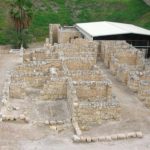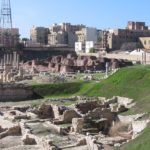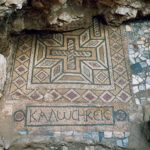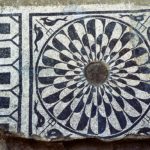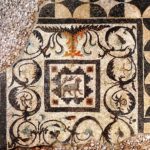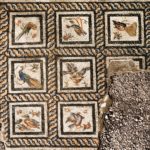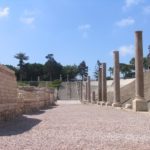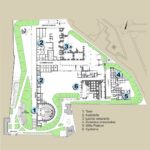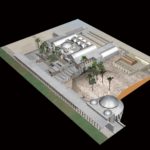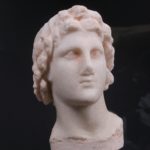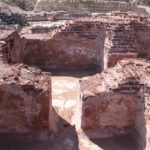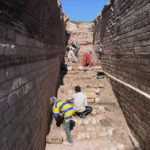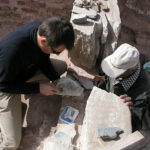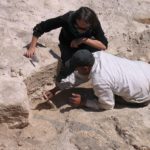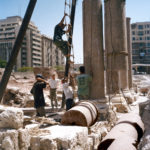Alexandria – Kom el-Dikka
-
Project name:
Polish-Egyptian Archaeological and Conservation Mission to Kom el-Dikka
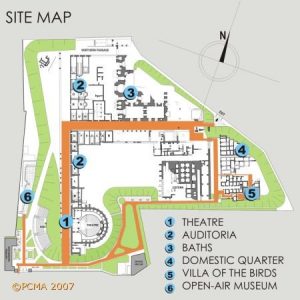
-
Type of site:
Ancient city and necropolis
Location:
Egypt
Modern Alexandria, center of ancient AlexandriaDating:
– Ptolemaic period (2nd–1st century BC)
– Roman period (1st–3rd century AD)
– late antique and Byzantine period (4th–7th century AD)
– early Islamic period (8th–13th century AD)It is the only ancient “university” discovered so far in the whole of the Mediterranean area.
Most interesting finds:
– complex of late Roman auditoria – the only archaeologically excavated ancient university complex /Fig. 1, 2/
– complex of Imperial baths with cisterns (and a unique water tower) /Fig. 3, 4/
– the only Roman theater excavated in Egypt /Fig. 5, 6/
– monumental portico /Fig. 13/
– late Roman domestic quarter
– houses from the Roman period decorated with mosaics in the domestic quarter /Fig. 7, 8, 9, 10, 11, 12/
History of research:
Dates of PCMA mission’s work:
1960–
Type of research:
excavations, conservation project
Directors:
Leszek Dąbrowski (1960–1962)
Stanisław Jasiewicz (1962)
Władysław Kubiak (1963–1966)
Wojciech Kołątaj (1966–1972)
Mieczysław Rodziewicz (1972–1984)
Wojciech Kołątaj (1984–2001)
Grzegorz Majcherek, Polish Centre of Mediterranean Archaeology, University of Warsaw (2002–)
Directors of archaeological study programs reporting to the Director of research:
Zsolt Kiss (1986–1987)
Grzegorz Majcherek (1988–2001)
Co-operating institutions:
– Polish Centre of Mediterranean Archaeology, University of Warsaw
– Egyptian Ministry of State for Antiquities
– National Museum in Warsaw
– Institute of Mediterranean and Oriental Cultures Polish Academy of Sciences (formerly Research Center for Mediterranean Archaeology Polish Academy of Sciences)
– State Archaeological Museum in Warsaw
– Warsaw University of Technology
Additional information:
Work on Kom el-Dikka was started in 1960 by Prof. Kazimierz Michałowski as salvage excavations but soon turned into regular archaeological fieldwork. It has been conducted from the very beginning by the Polish Centre of Mediterranean Archaeology, University of Warsaw in close cooperation with the Egyptian Ministry of State for Antiquities. A joint Polish-Egyptian mission was established in the 1980s in order to realize a large-scale conservation project aimed at transforming the site into an archaeological park. The Prime Minister of Poland and the Andrew Mellon Foundation provided funds for the mission. In 1998–1999, as part of a grant awarded by USAID, a pavilion housing the exposition of floor mosaics undergoing treatment in the original place of discovery was erected.
Description of the site and research:
Kom el-Dikka, located in the center of modern Alexandria, is both the biggest and the only archaeological site which allows researchers to study the urban fabric of this ancient city in a wider urban context /Fig. 14, 15, 19/. The excavations conducted here for more than half a century have led to a better understanding of the city’s past, from topography and architecture to the daily life of its inhabitants, during a very long period: from the 2nd century BC through the 14th century AD.
In the first three centuries of our era, the whole area of the site was covered with magnificent city residences. Their rich architectural decoration, wall paintings and sculptures, including depictions of Alexander the Great himself /Fig. 16/, as well as colorful floor mosaics with geometric, floral and figurative decorations /Fig. 9, 10, 11, 12/ are the best illustration of the grandeur and wealth of the city’s inhabitants. At the end of the 3rd century AD, the city was considerably destroyed as a result of political turbulence, rebellions and bloody pacifications ordered by Roman emperors. Although it was later rebuilt, it never returned to its former glory. New, significantly smaller and more modest houses, often multi-storied and inhabited by several families, accommodated now also workshops producing bronze and glass objects.
In the 4th century AD, the center of the city became a huge construction site. The core of the new large-scale urban project was a complex of big Imperial baths flanked by monumental colonnades /Fig. 3, 4/. Numerous public buildings were built around it /Fig. 15/, including spacious bathing chambers which could accommodate hundreds of users every day, bathing pools, gymnasia for sports, public latrines. A complex system of furnaces was used for heating water, which was drawn from the nearby cisterns /Fig. 17, 18/.
A wide colonnade portico running north-south was a monumental setting for the unique academic complex, comprising 22 auditoria, which was built here in the 6th century AD. It is the only ancient “university” discovered so far in the whole of the Mediterranean area. No wonder that ancient Alexandria, at the time one of the leading centers of education and learning, is nowadays called the “Oxford” of late antiquity.
The perfectly preserved auditoria /Fig. 1, 2/, built in a row along the portico, were furnished with low stone benches for students and an elevated seat for the lecturer. The nearby theater, a symbol of both the site and the city, was first used as an odeon for music performances. At the beginning of the 6th century, when its auditorium was rebuilt in a horseshoe shape and a roof was added, the theater became the largest room of the complex, the auditorium maximum. Both the auditoria with the theater and the baths constituted the social and cultural center of late antique Alexandria.
At the end of the 7th century AD, Alexandria was in decline. Grand public edifices were abandoned and devastated. In the following centuries, the whole area was turned into a large rubbish dump and cemetery – a truly symbolic end to a great city.
Conservation is an important part of the mission’s work at Kom el-Dikka. As a result, an archaeological park of almost 4 ha was established at the site /Fig. 13, 18, 20, 21, 22/. Monumental ancient buildings, the only ones of their kind preserved in the whole of Egypt, can be seen here in their original urban setting. The theater and auditoria, baths, cisterns, houses and colonnade porticoes have become part of the landscape of the modern metropolis and are nowadays one of the biggest tourist attractions.
Research results:
Season by season – “PCMA Newsletter”:
Season 2016
Season 2015
Season 2014
Season 2013
Season 2012
Season 2011
Season 2010
Season 2009
Season 2008
Season 2007
Season 2006
Events connected with the project:
2017-04-01 Kom el-Dikka, Alexandria: opening of the visitors’ route
2017-04-01 Opening in the Kom el-Dikka Archaeological Park
with accompanying leaflet: Alexandria, Kom el-Dikka
2017-12-06 Conservation award for PCMA architect
2012-06-28 Exhibition: “The Alexandrian School. Polish research on Kom el-Dikka 1960-2011“
with accompanying book (in Polish): “Starożytna Aleksandria. 50 lat polskich badań archeologicznych i prac konserwatorskich na Kom el-Dikka”
Media information and popular publications
Kucharczyk, R. (2017). W parku archeologicznym na Kom el-Dikka (In the Kom el-Dikka Archaeological Park). Pismo Uczelni „UW”, 2, 18–19.
Tkaczow, B. (2014). Pod Muz egidą (Under the aegis of the Muses). Polityka. Niezbędnik Inteligenta.
Kucharczyk, R., Majcherek, G., Pawlicki, F., and Koła̜taj, W. (2012). Starożytna Aleksandria. Polskie badania archeologiczne i prace konserwatorskie na Kom el-Dikka (Ancient Alexandria. Polish archaeological excavations and conservation work at Kom el-Dikka). Warsaw: PCMA UW.
Tkaczow, B. (2005). Odkrywanie starożytnej Aleksandrii (Discovering ancient Alexandria). In Egipt: bogowie i faraonowie. Oxford Educational.
Derda, T. (2004). Akademia Aleksandryjska. Nowe odkrycie polskich archeologów (The Alexandrian Academy. New discovery of Polish archaeologists). Mówią Wieki, 3, 22–26.
Derda, T. and Markiewicz, T. (2004). Odkopana akademia (Uncovered academy). Świat Nauki, 11, 49–57.
Łukaszewicz, A. (2004). Rok 41 – Rzym i Aleksandria (Year 41 – Rome and Alexandria). In A. Sołtysiak (ed.), Zamach stanu w dawnych społecznościach (pp. 115–120). Warszawa: OBTA.
Majcherek, G. (2004). Odkrycie starożytnej akademii w Aleksandrii (The discovery of an ancient academy in Alexandria). Kwartalnik Uniwersytetu Warszawskiego, 3, 10–11.
Łukaszewicz, A. (2001). Kamień z Kom el-Dikka (A stone from Kom el-Dikka). Archeologia Żywa, 6(1), 16–19.
Łukaszewicz, A. (1997). Polacy na Kom el-Dikka czyli Alexandrea rediviva (Poles on Kom el-Dikka, or Alexandrea rediviva). Archeologia Żywa, 2(4), 32–34.
Tkaczow, B. (1988). Aleksandria: najjaśniejsza, najpiękniejsza, najświetniejsza (Alexandria: the most brilliant and beautiful). Warszawa: Krajowa Agencja Wydawnicza.
Monographs
Mahler, R. (2021). Changing Life in Egyptian Alexandria: The Testimony of the Islamic Cemetery on Kom el-Dikka, (=Polish Publications in Mediterranean Archaeology 3), Leuven–Paris–Bristol: Peeters Publishers.
Tkaczow, B. (2010). Architectural styles of ancient Alexandria: Elements of architectural decoration from Polish excavations at Kom el-Dikka (1960–1993) (=Alexandrie 8). Warsaw: Centre d’archéologie méditerranéenne de l’Académie polonaise des Sciences.
Kołątaj, W., Majcherek, G., and Parandowska, E. (2007). Villa of the Birds: The excavation and preservation of the Kom al-Dikka mosaics (=American Research Center in Egypt Conservation Series 3). Cairo: American University in Cairo Press.
Kiss, Z., Majcherek, G., Meyza, H., Rysiewski, H., and Tkaczow, B. (2000). Fouilles polonaises à Kôm el-Dikka (1986–1987) (=Alexandrie 7). Warsaw: Centre d’archéologie méditerranéenne de l’Académie polonaise des sciences.
Tkaczow, B. (1993). The topography of ancient Alexandria: An archaeological map. Warsaw: Zakład Archeologii Śródziemnomorskiej, Polskiej Akadmii Nauk.
Koła̜taj, W. (1992). Imperial baths at Kom el-Dikka (=Alexandrie 6). Warsaw: Zakład Archeologii Śródziemnomorskiej Polskie Akademii Nauk.
Kiss, Z. (1989). Les ampoules de Saint Ménas découvertes à Kôm el-Dikka: 1961–1981 (=Alexandrie 5). Varsovie: PWN.
Kiss, Z. (1988). Sculptures des fouilles polonaises à Kom el-Dikka: 1960–1982 (=Alexandrie 4). Varsovie: Editions Scientifiques de Pologne.
Promińska, E. (1985). Variations de taille des habitants d’Alexandrie au cours des siècles (=Travaux du Centre d’archéologie méditerranéenne de l’Académie polonaise des sciences 25). Warsaw: Éditions scientifiques de Pologne.
Rodziewicz, M. (1984). Les habitations romaines tardives d’Alexandrie: à la lumière des fouilles polonaises à Kôm el-Dikka (=Alexandrie 3). Varsovie: Éditions Scientifiques de Pologne.
Borkowski, Z. (1981). Inscriptions des factions à Alexandrie (=Alexandrie 2). Varsovie: PWN.
Rodziewicz, M. (1976). La céramique romaine tardive d’Alexandrie (=Alexandrie 1). Varsovie: Éditions scientifiques de Pologne.
Promińska, E. (1972). Investigations on the population of Muslim Alexandria: Anthropological-demographic study (=Travaux du Centre d’archéologie méditerranéenne de l’Académie polonaise des sciences 12). Warsaw: Éditions scientifiques de Pologne.
Michałowski, K. (1971). Alexandria. Warsaw: Arkady.
Articles and reports
Kucharczyk, R. (in press). A lion and vegetal motif on an early Islamic scratch-engraved glass fragment from Alexandria, Journal of Glass Studies, 64,
Kucharczyk, R. (2021). Fragments of a vessel with gold-leaf decoration from Alexandria, Journal of Glass Studies, 63, 45–56
Majcherek, G. (2021). Streets and houses of Roman Alexandria revisited. Antiquity, 1-8. doi:10.15184/aqy.2020.242
Kucharczyk, R., (2020). Glass finds from Area FW at the Kom el-Dikka site in Alexandria (2019), Polish Archaeology in the Mediterranean 29/2, 497–513 DOI: 10.31338/uw.2083-537X.pam29.2.21
Lichocka, B. (2020). Trois monnaies « isiaques » de Kôm el-Dikka à Alexandrie (saisons de fouilles 1963–2006), In K. Jakubiak, A. Łajtar (eds), Ex Oriente Lux. Studies in Honour of Jolanta Młynarczyk, Warsaw: University of Warsaw Press, 35–44. https://doi.org/10.31338/uw.9788323541073
Tkaczow, B. (2020). Plateia, Pedion, “Canopic Street”: Archaeological evidence of the main street of ancient Alexandria. In K. Jakubiak, A. Łajtar (eds), Ex Oriente Lux. Studies in Honour of Jolanta Młynarczyk, 25–34. https://doi.org/10.31338/uw.9788323541073
Kucharczyk, R. (2019). Two Fragments of Early Islamic Cameo Glass from Alexandria, Journal of Glass Studies 61, 1–12.
Kucharczyk, R. (2019). Glass finds and other artifacts from excavations of Area FW at the Kom el-Dikka site in Alexandria in 2018. Polish Archaeology in the Mediterranean, 28/2, 43–60. DOI: 10.31338/uw.2083-537X.pam28.2.03
Majcherek, G. (2019). Survival or Revival? Urban and Architectural Change in Post-Classical Alexandria. In G. Bąkowska-Czerner, R. Czerner (eds), Greco-Roman Cities at the Cross-Roads of Cultures. The 20th Anniversary of Polish-Egyptian Conservation Mission Marina el-Alamein (pp. 144–161). Oxford: Archeopress.
Majcherek, G. (2019). Alexandria Kom el-Dikka. Excavations and preservation work in the 2018 season. Polish Archaeology in the Mediterranean, 28/2, 21–42. DOI: 10.31338/uw.2083-537X.pam28.2.02
Majcherek G. (2018) Alexandria. Kom el-Dikka. Season 2017Polish Archaeology in the Mediterranean, 27/1, 35–56
Majcherek, G. (2018). Crumbs from the table – archaeological remains of Hellenistic Alexandria. In Hellenistic Alexandria. Celebrating 24 centuries. International Conference, Athens, 12–15 December 2017, Acropolis Museum (pp. 71–85). Oxford: Archeopress.
Kucharczyk, R. (2017). Glass from Area CV on Kom el-Dikka (Alexandria). Season 2016, Appendix to Majcherek, G. Alexandria, Kom el-Dikka. Season 2016. Polish Archaeology in the Mediterranean, 26/1, 54–58.
Redlak, M. (2017). Egyptian imitations of Chinese celadon from the 13th–15th centuries from Kom el-Dikka in Alexandria. Polish Archaeology in the Mediterranean, 26/1, in press.
Kucharczyk, R. (2016). Glass finds from areas U and G at the Kom el-Dikka site in Alexandria (excavations in 2012 and 2013). Polish Archaeology in the Mediterranean, 25, 87–103.
Kucharczyk, R. (2016). Mosaic floral plaque fragment from Alexandria. Études et Travaux, 29, 125–134.
Mahler, R. and Okularczyk, U. (2016). Kom el-Dikka 2014: human bones from Area U. Polish Archaeology in the Mediterranean, 25, 64–86.
Majcherek, G. (2016). Alexandria, Kom-el-Dikka. Seasons 2014–2015. Polish Archaeology in the Mediterranean, 25, 33–52.
Kucharczyk, R. (2015). Islamic glass from sector U (2012–2013). Polish Archaeology in the Mediterranean, 24/1, 73–86.
Kulicka, E. (2015). Islamic necropolis at Kom el-Dikka in Alexandria: research in the 2010–2013 seasons. Polish Archaeology in the Mediterranean, 24/1, 62–72.
Lach, K. (2015). Monetization of Roman Egypt during the Flavian dynasty (AD 69–96): The case of Alexandria and Berenike. Polish Archaeology in the Mediterranean, 24/1, 727–734.
Majcherek, G. (2015). Alexandria. Excavations and preservation work on Kom el-Dikka. Seasons 2012 and 2013. Polish Archaeology in the Mediterranean, 24/1, 29–61.
Kiss, Z. (2014). Têtes alexandrines. In G. Tallet and C. Zivie-Coche (eds), Le myrte et la rose: mélanges offerts à Françoise Dunand par ses élèves, collègues et amis I (pp. 143–148). Montpellier: Équipe Égypte nilotique et méditerranéenne.
Kucharczyk, R. (2014). A fragment of dichroic glass from Alexandria. Journal of Glass Studies, 56, 29–35.
Łukaszewicz, A. (2014). Alexander and Alexandria – a view from Kom el-Dikka. In V. Grieb, K. Nawotka, and A. Wojciechowska (eds), Alexander the Great and the East: History, art, tradition, Wrocław, Breslau, 18.–19. Nov. 2011 (pp. 307–314). Wiesbaden: Harrassowitz Verlag.
Łukaszewicz, A. (2014). Lecture halls at Kom el-Dikka in Alexandria. In M. Dzielska and K. Twardowska (eds), Divine men and women in the history and society of late Hellenism (pp. 101–112). Kraków: Jagiellonian University Press.
Majcherek, G. and Kucharczyk, R. (2014). Alexandria. Excavations and preservation work on Kom el-Dikka. Season 2011. Polish Archaeology in the Mediterranean, 23/1, 23–44.
Tkaczow, B. (2014). Fragments of wall paintings from Polish excavations at Kom el-Dikka, Alexandria. Études et Travaux, 27, 421–439.
Dobrowolski, J. (2013). Villa of the Birds five years later: Early Roman mosaics in Alexandria, Egypt. In A. ben A. Ben Khader, M. Demas, and T. Roby (eds), Lessons learned: Reflecting on the theory and practice of mosaic conservation. Proceedings of the 9th ICCM Conference, Hammamet, Tunisia, November 29–December 3, 2005 (pp. 51–56). Los Angeles: Getty Conservation Institute.
Łukaszewicz, A. (2013). From Thebaid to Alexandria: Polish archaeological activities in Egypt. Kiev: National Academy of Sciences of Ukraine.
Majcherek, G. (2013). Alexandria. Excavations and preservation work on Kom el-Dikka. Preliminary report 2009/2010. Polish Archaeology in the Mediterranean, 22, 33–53.
Majcherek, G. (2013). Archéologie d’un campus: Alexandrie (Ve–VIIe siècle). In É. Vallet, S. Aube, and T. Kouamé (eds), Lumières de la sagesse: écoles médiévales d’Orient et d’Occident (pp. 28–29). Paris: Institut du monde arabe.
Meyza, H. and Więch, M. (2013). Cypriot Sigillata from Kom el-Dikka excavations in Alexandria found before 1986. Études et Travaux, 26.2, 463–471.
Tkaczow, B. (2013). Historical topography of ancient Alexandria. Études et Travaux, 26.2, 685–697.
Juchniewicz, K. and Lach, K. (2012). Auditorium E: exploration in season 2009, appendix to: G. Majcherek, Alexandria Kom el-Dikka: excavations and preservation work. Preliminary report 2008/2009. Polish Archaeology in the Mediterranean, 21, 43–47.
Kucharczyk, R. (2012). Glass vessels decorated with Christian symbols from Alexandria. Études et Travaux, 25, 149–158.
Łukaszewicz, A. (2012). Second thoughts on the beginnings of Alexandria. Études et Travaux, 25, 205–211.
Mahler, R. (2012). Kom el-Dikka 2005–2009: selected anthropological research. Polish Archaeology in the Mediterranean, 21, 49–58.
Majcherek, G. (2012). Alexandria Kom el-Dikka: excavations and preservation work. Preliminary report 2008/2009. Polish Archaeology in the Mediterranean, 21, 27–48.
Jegliński, A. (2011). Numismatic finds from Kom el-Dikka (Alexandria), 2008. Polish Archaeology in the Mediterranean, 20, 70–79.
Kucharczyk, R. (2011). Glass from Area F on Kom el-Dikka (Alexandria). Excavations 2008. Polish Archaeology in the Mediterranean, 20, 56–69.
Kucharczyk, R. (2011). Glass medallion in the shape of a lion’s head mask. In H. Meyza and I. Zych (eds), Classica orientalia: Essays presented to Wiktor Andrzej Daszewski on his 75th birthday (pp. 277–285). Warsaw: PCMA UW; Wydawnictwo DiG.
Kulicka, E. (2011). Remarks on the typology of Islamic graves from the cemeteries on Kom el-Dikka in Alexandria. Polish Archaeology in the Mediterranean, 20, 483–498.
Kulicka, E. (2011). The Islamic graveyard on Kom el-Dikka in Alexandria. Excavation season 2007/2008. Polish Archaeology in the Mediterranean, 20, 52–55.
Lichocka, B. (2011). Claudius’s issue of silver drachmas in Alexandria: Serapis Anastole. In N. Holmes (ed.), Proceedings of the XIVth International Numismatic Congress, Glasgow 2009 (pp. 800–808). Glasgow: International Numismatic Council.
Łukaszewicz, A. (2011). Caesar in Alexandria. Fragmentary Latin dipinti discovered at Kom el-Dikka. Journal of Juristic Papyrology, 41, 79–92.
Majcherek, G. (2011). Alexandria: Kom el-Dikka excavations and preservation work. Preliminary report 2007/2008. Polish Archaeology in the Mediterranean, 20, 35–51.
Kiss, Z. (2010). Alexandria in the fourth to seventh centuries. In R.S. Bagnall (ed.), Egypt in the Byzantine world, 300–700 (pp. 187–207). Cambridge: Cambridge University Press.
Kiss, Z. (2010). L’édifice théâtral de Kom el-Dikka – quelques mythes et plusieurs question. In D. Robinson and A. Wilson (eds), Alexandria and the North-Western Delta: Joint conference proceedings of Alexandria: city and harbour (Oxford 2004) and, the trade and topography of Egypt’s North-West Delta, 8th century BC to 8th century AD (Berlin 2006) (pp. 91–101). Oxford: Oxford Centre for Maritime Archaeology, Institute of Archaeology.
Kucharczyk, R. (2010). Glass from Area F on Kom el-Dikka (Alexandria). Polish Archaeology in the Mediterranean, 19, 56–70.
Kulicka, E. (2010). The Islamic graveyard on Kom el-Dikka in Alexandria. Excavations in the 2006/2007 field season. Polish Archaeology in the Mediterranean, 19, 49–55.
Łukaszewicz, A. (2010). Textual research and the life of the amphorae. Some evidence from Late Roman Alexandria. In S. Menchelli, S. Santoro, M. Pasquinucci, and G. Guiducci (eds), LRCW 3: Late Roman coarse wares, cooking wares and amphorae in the Mediterranean. Archaeology and archaeometry. Comparison between Western and Eastern Mediterranean II (=BAR International Series 2185/2) (pp. 941–944). Oxford: Archaeopress.
Łukaszewicz, A. (2010). Von Alexandria bis Oberägypten. Polnische Archäologie im Lande der Pharaonen. Jahrbuch des Wissenschaftlichen Zentrums der Polnischen Akademie der Wissenschaften in Wien, 3, 173–192.
Majcherek, G. (2010). Alexandria. Excavations and preservation work. Preliminary report 2006/2007. Polish Archaeology in the Mediterranean, 19, 31–48.
Majcherek, G. (2010). Discovering Alexandria – Archaeological update on the finds from Kom el-Dikka. In D. Robinson and A. Wilson (eds), Alexandria and the North-Western Delta: Joint conference proceedings of Alexandria: city and harbour (Oxford 2004) and, the trade and topography of Egypt’s North-West Delta, 8th century BC to 8th century AD (Berlin 2006) (pp. 75–89). Oxford: Oxford Centre for Maritime Archaeology, Institute of Archaeology.
Majcherek, G. (2010). The auditoria on Kom el-Dikka. A glimpse of late antique education in Alexandria. In T. Gagos and A. Hyatt (eds), Proceedings of the 25th International Congress of Papyrology Ann Arbor, July 29 – August 4, 2007 (pp. 471–484). Ann Arbor, MI: University of Michigan Library, Scholarly Publishing Office.
Kucharczyk, R. (2009). Islamic scratch-engraved glass from Alexandria (Kom el-Dikka). Journal of Glass Studies, 51, 40–52.
Łukaszewicz, A. (2009). Od Aleksandrii do Doliny Królów (From Alexandria to the Valley of the Kings). In B. Kaim (ed.), Blisko i daleko: księga jubileuszowa Instytutu Archeologii Uniwersytetu Warszawskiego (pp. 229–232). Warszawa: Instytut Archeologii UW.
Łukaszewicz, A. (2009). Ostraca and architecture at Kom el-Dikka. Journal of Juristic Papyrology, 39, 121–131.
Majcherek, G. (2009). Alexandria 2005/2006 preliminary report. Annales du Service des Antiquités de l’Égypte, 82.
Majcherek, G. (2009). Alexandria. Excavations and preservation work. Preliminary report 2007/2008. Mishkah. Egyptian Journal of Islamic Archaeology, 4, 153–175.
Rodziewicz, E. (2009). Ivory, bone, glass and other production at Alexandria, 5th-9th centuries. In M.M. Mango (ed.), Byzantine trade, 4th–12th centuries: The archaeology of local, regional and international exchange. Papers of the thirty-eighth Spring Symposium of Byzantine Studies, St John’s College, University of Oxford, March 2004 (pp. 83–95). Farnham: Ashgate Publishing.
Kulicka, E. (2008). Moslem cemetery in Areas CW and L on Kom el-Dikka (excavations in the 2005/2006 season), appendix to: G. Majcherek, Kom el-Dikka. Excavation and preservation work, 2005/2006. Polish Archaeology in the Mediterranean, 18, 45–50.
Lichocka, B. (2008). Un tétradrachme de Néron, dit « miroir de Néron », trouvé à Kôm el-Dikka à Alexandrie. In D. Gerin, A. Geissen, and M. Amandry (eds), Aegyptiaca serta in Soheir Bakhoum memoriam: mélanges de numismatique, d’iconographie et d’histoire (pp. 49–58). Milano: Ennerre.
Majcherek, G. (2008). Academic life of late antique Alexandria: view from the field. In M. el Abbadi and O.M. Fathallah (eds), What happened to the ancient library of Alexandria? (pp. 191–206). Leiden: Brill.
Majcherek, G. (2008). Kom el-Dikka. Excavation and preservation work, 2005/2006. Polish Archaeology in the Mediterranean, 18, 29–40.
Kucharczyk, R. (2007). Late Roman/early Byzantine glass from the auditoria on Kom el-Dikka in Alexandria. Polish Archaeology in the Mediterranean, 17, 45–53.
Mahler, R. (2007). Analysis of skeletal material from the Kom el-Dikka site, 2004/2005 season. Polish Archaeology in the Mediterranean, 17, 40–44.
Majcherek, G. (2007). Alexandria – current research. In E. Laskowska-Kusztal (ed.), Seventy years of Polish archaeology in Egypt (pp. 125–134). Warsaw: PCMA UW.
Majcherek, G. (2007). Houses of Alexandria. Some aspects of architectural development in the Roman period. In K. Galor and T. Waliszewski (eds), From Antioch to Alexandria: Recent studies in domestic architecture (pp. 201–207). Warsaw: Institute of Archaeology, University of Warsaw.
Majcherek, G. (2007). Kom el-Dikka. Excavation and preservation work. Preliminary report, 2004/2005. Polish Archaeology in the Mediterranean, 17, 21–34.
Majcherek, G. (2007). The late Roman auditoria of Alexandria: an archaeological overview. In T. Derda, T. Markiewicz, and E. Wipszycka (eds), Alexandria: Auditoria of Kom el-Dikka and late antique education (=Journal of Juristic Papyrology Supplement 8) (pp. 11–50). Warsaw: University of Warsaw, Faculty of Law and Administration.
Łukaszewicz, A. (2006). Encore Isidoros : du nouveau sur un turbulent gymnasiarque d’Alexandrie. In D. Długosz (ed.), Grecs, Juifs, Polonais à la recherche des racines de la civilisation européenne: actes du colloque (pp. 154–159). Paris: Centre scientifique de l’Académie polonaise des sciences à Paris.
Łukaszewicz, A. (2006). Violence in Alexandria. Classica Cracoviensia, 10, 132–134.
Kucharczyk, R. (2005). Islamic glass from the auditoria on Kom el-Dikka in Alexandria. Polish Archaeology in the Mediterranean, 16, 31–41.
Lichocka, B. (2005). Bilan des découverts monétaires dans les fouilles polonaises d’Alexandrie. In F. Duyrat and O. Picard (eds), L’exception égyptienne ? Production et échanges monétaires en Égypte hellénistique et romaine. Actes du colloque d’Alexandrie, 13–15 avril 2002 (=Études Alexandrines 10) (pp. 299–311). Cairo: Institut français d’archéologie orientale.
Lichocka, B. (2005). Late Roman coin-finds from Kom el-Dikka in Alexandria. In C. Alfaro, C. Marcos, and P. Otero (eds), XIII Congreso Internacional de Numismática, Madrid, 2003: Actas (pp. 763–769). Madrid: Ministerio de Cultura, Secretaría General Técnica.
Majcherek, G. (2005). Kom el-Dikka: excavation and preservation work, 2003/2004. Polish Archaeology in the Mediterranean, 16, 17–30.
Meyza, H. (2005). Stamped late Hellenistic and early Roman fine wares found at Kom el-Dikka in Alexandria before 1987. Études et Travaux, 20, 121–136.
Kucharczyk, R. (2004). Two Roman toilet bottles from Kom el-Dikka. Polish Archaeology in the Mediterranean, 15, 43–45.
Lis, J. (2004). Mosaic conservation at Kom el-Dikka in Alexandria in 2002. Polish Archaeology in the Mediterranean, 15, 39–42.
Majcherek, G. (2004). Alexandria’s long-distance trade in Late Antiquity – the amphora evidence. In J. Eiring and J. Lund (eds), Transport amphorae and trade in the Eastern Mediterranean: Acts of the international colloquium at the Danish Institute at Athens, September 26–29, 2002 (=Monographs of the Danish Institute at Athens 5) (pp. 229–238). Aarhus: Aarhus University Press.
Majcherek, G. (2004). Kom el-Dikka, excavations and preservation work, 2002/2003. Polish Archaeology in the Mediterranean, 15, 25–38.
Redlak, M. (2004). Syro-Egyptian underglaze painted ceramics from Kom el-Dikka, 13th-15th century. Study report (2002/2003). Polish Archaeology in the Mediterranean, 15, 46–52.
Majcherek, G. (2003). Mosaic floors from Roman triclinia in Alexandria. Evolution of techniques and design. In Z. Hawass and L.P. Brock (eds), Egyptology at the dawn of the Twenty-first Century: Proceedings of the Eighth International Congress of Egyptologists, Cairo, 2000, I (pp. 319–327). Cairo: American University in Cairo Press.
Majcherek, G. and Kołątaj, W. (2003). Alexandria, excavations and preservation work, 2001/2002. Polish Archaeology in the Mediterranean, 14, 19–31.
Parandowska, E. (2003). Conservation of mosaics from the early Roman villa at Kom al-Dikka, Alexandria. In P. Blanc (ed.), Les mosaïques, conserver pour présenter: actes, VIIe conférence du comité international pour la conservation des mosaïques, 22–28 novembre 1999 (pp. 103–110). Arles: Musée de l’Arles et de la Provence antiques.
Rodziewicz, E. (2003). On Alexandrian school of ivory carving in late antiquity. Bulletin de la Société Archéologique d’Alexandrie, 47, 49–69.
Zych, I. (2003). Wooden coffins from the Moslem cemetery at Kom el-Dikka. Polish Archaeology in the Mediterranean, 14, 32–37.
Koła̜taj, W. (2002). Kom el-Dikka, preservation work, 2000/2001. Polish Archaeology in the Mediterranean, 13, 23–29.
Łukaszewicz, A. (2002). Ostatni ślad Atanazego (The last trace of Athanasius). In B. Iwaszkiewicz-Wronikowska and D. Próchniak (eds), Sympozja Kazimierskie poświęcone kulturze świata późnego antyku i wczesnego chrześcijaństwa III (pp. 209–213). Lublin: Towarzystwo Naukowe Katolickiego Uniwersytetu Lubelskiego.
Majcherek, G. (2002). Kom el-Dikka, excavations 2000/2001. Polish Archaeology in the Mediterranean, 13, 31–43.
Tkaczow, B. (2002). Remarques sur la topographie et l’architecture de l’ancienne Alexandrie à la lumière des récentes découvertes archéologiques. Archeologia, 53, 21–37.
Jabłonowska-Taracha, J. (2001). Bone objects from Polish excavations at Kom el-Dikka, Alexandria (1988–1990), part II. Archeologia, 52, 61–75.
Koła̜taj, W. (2001). Kom el-Dikka, preservation work, 1999/2000. Polish Archaeology in the Mediterranean, 12, 17–22.
Łukaszewicz, A. (2001). Tiberius Claudius Isidorus; Alexandrian gymnasiarch and epistrategus of Thebaid. In T. Gagos and R.S. Bagnall (eds), Essays and texts in honor of J. David Thomas (pp. 125–129). Oakville, CT: American Society of Papyrologists.
Majcherek, G. (2001). Kom el-Dikka, excavations, 1999/2000. Polish Archaeology in the Mediterranean, 12, 23–34.
Tkaczow, B. (2001). Topographie et architecture de l’ancienne Alexandrie. Nouvelles recherches et découvertes. Études et Travaux, 19, 329–336.
Daszkiewicz, M., Redlak, M., and Bobryk, E. (2000). Some aspects of technology of Islamic glazed pottery from Alexandria. Paper presented during Archäometrie und Denkmalpflege, Dresden.
Jabłonowska-Taracha, J. (2000). Bone objects from Polish excavations at Kom el-Dikka, Alexandria (1988–1990), part I. Archeologia, 51, 51–60.
Koła̜taj, W. (2000). Kom el-Dikka, preservation work, 1998/99. Polish Archaeology in the Mediterranean, 11, 19–25.
Kubiak, W.B. (2000). Islamic finds – storehouse survey 1995/96. In V. Christides and T. Papadopoulos (eds), Proceedings of the sixth International Congress of Graeco-Oriental and African Studies, Nicosia 30 April–5 May 1996. Nicosia: Archbishop Makarios 3. Cultural Centre, Bureau of the History of Cyprus.
Łukaszewicz, A. (2000). Some remarks on the trial of lsidorus and on Isidorus Junior. Journal of Juristic Papyrology, 30, 59–65.
Majcherek, G. (2000). Kom el-Dikka. Excavations, 1998/99. Polish Archaeology in the Mediterranean, 11, 27–38.
Kiss, Z. (1999). Les auriges de Kôm el-Dikka. In J. Śliwa (ed.), Centenary of mediterranean archaeology, 1897–1997: International symposium, Cracow, October 1997 (pp. 135–142). Cracow: Instytut Archeologii UJ.
Kiss, Z. (1999). Un portrait d’Alexandre le Grand récemment trouvé à Alexandrie. Światowit, 1(42) Fasc. A, 34–36.
Koła̜taj, W. (1999). Alexandria. In K.A. Bard and S.B. Shubert (eds), Encyclopedia of the archaeology of ancient Egypt (pp. 146–150). London: Routledge.
Koła̜taj, W. (1999). Kom el-Dikka. Preservation work, 1997/98. Polish Archaeology in the Mediterranean, 10, 21–28.
Majcherek, G. (1999). Kom el-Dikka. Excavations, 1997/98. Polish Archaeology in the Mediterranean, 10, 29–39.
Majcherek, G. (1999). Excavations at Kom el-Dikka 1997–1998. A preliminary report. Annales du Service des Antiquités de l’Égypte, 74, 39–55.
Koła̜taj, W. (1998). Kom el-Dikka preservation work 1996/97. Polish Archaeology in the Mediterranean, 9, 17–22.
Koła̜taj, W. (1998). Theoretical reconstruction of the Late Roman theatre at Kom el-Dikka in Alexandria. In C. Eyre (ed.), Proceedings of the Seventh International Congress of Egyptologists, Cambridge, 3–9 September 1995 (=Orientalia lovaniensia analecta 82) (pp. 631–638). Leuven: Peeters.
Lichocka, B. (1998). Les monnaies alexandrines trouvées à Kôm el-Dikka et quelques remarques sur l’atelier alexandrin. In J.-Y. Empereur (ed.), Commerce et artisanat dans l’Alexandrie hellénistique et romaine. Actes du Colloque d’Athènes organisé par le CNRS, le Laboratoire de céramologie de Lyon et l’École française d’Athènes, 11–12 décembre 1988 (=Bulletin de correspondance héllenique Supplément 33) (pp. 453–465). Athens: École française d’Athènes.
Lichocka, B. (1998). Une monnaie de plomb de Kom el-Dikka à Alexandrie. Kwartalnik Historii Kultury Materialnej, 46(1–2), 93–98.
Majcherek, G. (1998). Excavations at the Kom el-Dikka site. Newsletter of the Archaeological Society in Alexandria, 4, 3–6.
Majcherek, G. (1998). Kom el-Dikka excavations 1997. Polish Archaeology in the Mediterranean, 9, 23–36.
Młynarczyk, J. (1998). Italian and Alexandrian terracotta lamps: a pattern of influence. The first through fourth century A.D. In N. Bonacasa (ed.), L’Egitto in Italia: dall’antichità al medioevo: atti del 3. congresso internazionale italo-egiziano, Roma CNR-Pompei, 13–19 novembre 1995 (pp. 453–466). Roma: Consiglio Nazionale delle Ricerche.
Młynarczyk, J. (1998). Terracotta mould-made lamps in Alexandria. Hellenistic to late Roman period. In J.-Y. Empereur (ed.), Commerce et artisanat dans l’Alexandrie hellénistique et romaine. Actes du Colloque d’Athènes organisé par le CNRS, le Laboratoire de céramologie de Lyon et l’École française d’Athènes, 11–12 décembre 1988 (=Bulletin de correspondance héllenique Supplément 33) (pp. 327–352). Athens: École française d’Athènes.
Rodziewicz, M. (1998). Transformation of ancient Alexandria into a medieval city. In R.-P. Gayraud (ed.), Colloque International d’Archéologie Islamique: IFAO, Le Caire, 3–7 février 1993 (pp. 369–386). Cairo: Institut français d’archéologie orientale.
Koła̜taj, W. (1997). Kom el-Dikka preservation work 1995–1996. Polish Archaeology in the Mediterranean, 8, 13–16.
Kubiak, W.B. and Redlak, M. (1997). Kom el-Dikka. Islamic finds – storehouses survey 1995/96. Polish Archaeology in the Mediterranean, 8, 32–39.
Majcherek, G. (1997). Kom el-Dikka excavations 1995–1996. Polish Archaeology in the Mediterranean, 8, 17–31.
Młynarczyk, J. (1997). Alexandrian and Alexandria-influenced mould-made lamps of the Hellenistic period (=BAR International Series 677). Oxford: Archaeopress.
Daszewski, W.A. (1996). From Hellenistic polychromy of sculptures to Roman mosaics. In Alexandria and Alexandrianism: Papers delivered at a symposium organized by the J. Paul Getty Museum and the Getty Center for the History of Art and the Humanities and held at the Museum, April 22–25, 1993 (pp. 141–154). Malibu, CA: J. Paul Getty Museum.
Koła̜taj, W. (1996). Polish–Egyptian Preservation Mission at Kom el-Dikka 1994–1995. Polish Archaeology in the Mediterranean, 7, 7–12.
Łukaszewicz, A. (1996). Une inscription d’Alexandrie (I. Alex. Inv. 4399). Journal of Juristic Papyrology, 26, 99–103.
Majcherek, G. (1996). Excavations at Kom el-Dikka 1995. Polish Archaeology in the Mediterranean, 7, 13–22.
Kiss, Z. (1995). Hélios embrasse Sérapis. In A. Bursche, M. Mielczarek, and W. Nowakowski (eds), Nunc de suebis dicendum est: studia archaeologica et historica Georgio Kolendo ab amicis et discipulis dicata (pp. 137–138). Warszawa: Instytut Archeologii Uniwersytetu Warzawskiego.
Kiss, Z. (1995). Un portrait égyptien d’époque gréco-romaine trouvé à Alexandrie. In Alessandria e il mondo ellenistico-romano: 1. centenario del Museo greco-romano, Alessandria, 23–27 novembre 1992. Atti del 2. Congresso internazionale italo-egiziano (pp. 339–342). Rome: “L’Erma” di Bretschneider.
Koła̜taj, W. (1995). Alexandria. Polish–Egyptian Preservation Mission at Kom el-Dikka, 1993/94. Polish Archaeology in the Mediterranean, 6, 5–10.
Lichocka, B. (1995). Un ensemble de monnaies découvert à Kom el-Dikka (Alexandrie). In Alessandria e il mondo ellenistico-romano: 1. centenario del Museo greco-romano, Alessandria, 23–27 novembre 1992. Atti del 2. Congresso internazionale italo-egiziano (pp. 83–85). Rome: “L’Erma” di Bretschneider.
Lichocka, B. (1995). Une trouvaille des monnaies alexandrines du Haut Empire dans la maison H à Kôm el-Dikka (Alexandrie). Études et Travaux, 17, 111–115.
Majcherek, G. (1995). Alexandria 1994: archaeological excavations. Polish Archaeology in the Mediterranean, 6, 11–20.
Majcherek, G. (1995). Gazan amphorae: Typology reconsidered. In H. Meyza and J. Młynarczyk (eds), Hellenistic and Roman pottery in the Eastern Mediterranean: Advances in scientific studies. Acts of the II Nieborów Pottery Workshop, Nieborów, 18–20 December 1993 (pp. 163–178). Warsaw: Research Center for Mediterranean Archaeology, Polish Academy of Sciences.
Majcherek, G. (1995). Notes on Alexandrian habitat. Roman and Byzantine houses from Kom el-Dikka. Topoi, 5(1), 133–150.
Młynarczyk, J. (1995). New data on the chronology of late Roman lamps in Alexandria. Études et Travaux, 17, 133–175.
Rodziewicz, M. (1995). A review of the archaeological evidence concerning the cultural institutions in ancient Alexandria. Graeco-Arabica, 6, 317–332.
Tkaczow, B. (1995). An imitation of opus alexandrinum in wall painting? Two wall paintings from Kom el-Dikka (Alexandria). Études et Travaux, 17, 320–326.
Daszewski, W.A. (1994). Notes sur la trame urbaine de l’ancienne Alexandrie. Comptes rendus des séances de l’Académie des Inscriptions et Belles-Lettres, 138, 423–429.
Kiss, Z. (1994). L’evolution de la structure urbaine d’Alexandrie Romaine à la lumière des fouilles recentes. In La ciutat en el món romà: actes, XIV Congrés Internacional d’Arqueologia Clàssica, Tarragona, 5.–11.9.1993 (pp. 261–264). Tarragona: Associazione internazionale di archeologia classica.
Koła̜taj, W. (1994). Polish–Egyptian Restoration Mission at Kom el-Dikka, Alexandria, 1992–93. Polish Archaeology in the Mediterranean, 5, 5–10.
Majcherek, G. (1994). Excavations in Alexandria, 1992–93. Polish Archaeology in the Mediterranean, 5, 11–20.
Byliński, J. (1993). Marks and signatures of artisans on medieval Islamic pottery from Kom el-Dikka in Alexandria. Bulletin de la Société Archéologique d’Alexandrie, 45, 55–68.
Koła̜taj, W. (1993). Conservation work at Kom el-Dikka in Alexandria in the 1991–1992 season. Polish Archaeology in the Mediterranean, 4, 7–10.
Łukaszewicz, A. (1993). Alexandrie romaine – quelques aspects du commerce à la lumière des documents. Journal of Juristic Papyrology, 23, 105–113.
Majcherek, G. (1993). Excavations in Alexandria in 1991–1992. Polish Archaeology in the Mediterranean, 4, 11–22.
Rodziewicz, E. (1993). Late Roman auditoria in Alexandria in the light of ivory carvings. Bulletin de la Société Archéologique d’Alexandrie, 45, 269–279.
Rodziewicz, M. (1993). Remarks on Kom el-Demas in Alexandria. Graeco-Arabica, 5, 315–319.
Zych, I. (1993). A note on the collection of wooden objects from the Polish excavations at Kom el-Dikka in Alexandria. Bulletin de la Société Archéologique d’Alexandrie, 45, 413–427.
Kiss, Z. (1992). Alexandrie 1986. Études et Travaux, 16, 337–343.
Kiss, Z. (1992). Alexandrie 1987. Études et Travaux, 16, 345–351.
Kiss, Z. (1992). Les auditoria romains tardifs de Kôm el-Dikka (Alexandrie). Acta Antiqua Academiae Scientiarum Hungaricae, 33, 331–338.
Kiss, Z. (1992). Remarques sur la datation et les fonctions de l’edifice theatral à Kom el-Dikka. In S. Jakobielski and J. Karkowski (eds), 50 years of Polish excavations in Egypt and the Near East: Acts of the Symposium at the Warsaw University 1986 (pp. 171–178). Warsaw: Centre d’archéologie méditerranéenne de l’Académie polonaise des sciences.
Kiss, Z. (1992). Un sphinx sur un plat romain tardif de Kôm el-Dikka. Études et Travaux, 16, 30–34.
Koła̜taj, W. (1992). Report on the conservation activities at Kom el-Dikka in Alexandria in the spring season of 1991. Polish Archaeology in the Mediterranean, 3, 15–18.
Koła̜taj, W. (1992). The Late Roman baths at Kom el-Dikka in Alexandria. In S. Jakobielski and J. Karkowski (eds), 50 years of Polish excavations in Egypt and the Near East: Acts of the Symposium at the Warsaw University 1986 (pp. 179–186). Warsaw: Centre d’archéologie méditerranéenne de l’Académie polonaise des sciences.
Kołodziejczyk, K. (1992). Remarques sur les thermes privés à Kom el-Dikka (Alexandrie). Études et Travaux, 16, 58–65.
Lichocka, B. (1992). Les monnaies antiques trouvées dans le “Quartier d’habitation” à Kom el-Dikka (Alexandrie). Acta Antiqua Academiae Scientiarum Hungaricae, 33, 339–345.
Lichocka, B. (1992). Un tresor de monnaies byzantines à Kom el-Dikka (Alexandrie). Études et Travaux, 16, 66–78.
Łajtar, A. (1992). Dedication of the prostates of a synodos from Alexandria. Journal of Juristic Papyrology, 22, 29–37.
Łukaszewicz, A. (1992). An ostracon from Alexandria. In S. Jakobielski and J. Karkowski (eds), 50 years of Polish excavations in Egypt and the Near East: Acts of the Symposium at the Warsaw University 1986 (pp. 215–216). Warsaw: Centre d’archéologie méditerranéenne de l’Académie polonaise des sciences.
Majcherek, G. (1992). Alexandria, Kom el-Dikka, 1990–1991. Bulletin de Liaison de la Céramique Égyptienne, 16, 1–4.
Majcherek, G. (1992). Excavations in Alexandria in 1990–91. Polish Archaeology in the Mediterranean, 3, 5–14.
Majcherek, G. (1992). The Late Roman ceramics from sector G (Alexandria 1986–1987). Études et Travaux, 16, 81–117.
Rodziewicz, E. (1992). Remarks on chryselephantine statue from Alexandria. In G. Pugliese Carratelli (ed.), Roma e l’Egitto nell’antichità classica, Cairo, 6-9 Febbraio 1989: atti del I Congresso internazionale Italo-Egiziano (pp. 317–328). Roma: Istituto poligrafico e Zecca dello Stato : Libreria dello Stato.
Sztetyłło, Z. (1992). Timbres céramiques des fouilles polonaises à Alexandrie (1979–1982). Études et Travaux, 16, 151–178.
Sztetyłło, Z. (1992). Timbres céramiques des fouilles polonaises à Alexandrie (1982–1987). Études et Travaux, 16, 179–223.
Tkaczow, B. (1992). Observations préliminaires sur les fragments de décoration architectonique à Kôm el Dikka (Alexandrie). Études et Travaux, 16, 226–256.
Daszewski, W.A. (1991). A statuette of Hygieia from Kom el-Dikka in Alexandria. Mitteilungen des Deutschen Archäologischen Instituts. Abteilung Kairo, 47, 61–66.
Dzierżykray-Rogalski, T. and Grzeszyk, C. (1991). Les dermatoglyphes (empreintes des lignes papillaires) relevés sur des lampes alexandrines de Kôm el-Dikka (Alexandrie). Cahiers de la céramique égyptienne, 2, 125–128.
Koła̜taj, W. (1991). Conservation work on Kom el-Dikka in Alexandria in the 1989 season. Polish Archaeology in the Mediterranean, 2, 15–18.
Majcherek, G. (1991). Excavations at Kom el-Dikka in Alexandria 1989–1990. Pottery research. Bulletin de Liaison de la Céramique Égyptienne, 15, 1–3.
Majcherek, G. (1991). Excavations in Alexandria in 1989–90. Polish Archaeology in the Mediterranean, 2, 19–24.
Rodziewicz, E. (1991). Remains of a chryselephantine statue in Alexandria. Bulletin de la Société Archéologique d’Alexandrie, 44, 119–130.
Rodziewicz, M. (1991). A brief record of the excavations at Kom el-Dikka in Alexandria (1960–1980). Bulletin de la Société Archéologique d’Alexandrie, 44, 1–70.
Rodziewicz, M. (1991). Archaeological evidence on Byzantine architecture in Alexandria. Graeco-Arabica, 4, 287–293.
Rodziewicz, M. (1991). Excavations at Kom el-Dikka in 1980–1981. Bulletin de la Société Archéologique d’Alexandrie, 44, 71–83.
Rodziewicz, M. (1991). Opus sectile mosaics from Alexandria and Mareotis. In E. Dassmann (ed.), Tesserae: Festschrift für Josef Engemann (pp. 204–214). Münster: Aschendorff.
Rodziewicz, M. (1991). Report on the activities of the archaeological mission at Kom el-Dikka, Alexandria in 1982. Bulletin de la Société Archéologique d’Alexandrie, 44, 84–102.
Rodziewicz, M. (1991). Report on the excavations at Kom el-Dikka in Alexandria in 1983–1984. Bulletin de la Société Archéologique d’Alexandrie, 44, 103–118.
Borkowski, Z. (1990). Deux ostraca grecs des fouilles polonaises à Kôm el-Dikka. Études et Travaux, 14, 153–157.
Kiss, Z. (1990). Un portrait d’impératrice sur une lampe romaine des fouilles polonaises à Alexandrie. Études et Travaux, 15, 175–178.
Kołodziejczyk, K. (1990). Fragments d’enduits peints des fouilles polonaises à Kom el-Dikka (Alexandrie). Études et Travaux, 15, 193–202.
Lichocka, B. (1990). Remarques sur les monnaies romaines tardives trouvées à Kom el-Dikka. Études et Travaux, 15, 243–252.
Łukaszewicz, A. (1990). A terracotta lamp from Alexandria. Études et Travaux, 15, 253–255.
Łukaszewicz, A. (1990). Fragmenta Alexandrina I: some inscriptions from the Roman baths at Kom el Dikka. Zeitschrift für Papyrologie und Epigraphik, 82, 133–136.
Majcherek, G. (1990). Excavations at Kom el-Dikka in Alexandria in the 1989 season. Polish Archaeology in the Mediterranean, 1, 75–83.
Parandowski, P. (1990). Coptic terracotta figurines from Kom el-Dikka. In W. Godlewski (ed.), Coptic studies: Acts of the Third International Congress of Coptic Studies, Warsaw, 20–25 August, 1984 (pp. 303–309). Warsaw: PWN.
Rodziewicz, M. (1990). Gobelet peint médiéval en oeuf d’autruche. Études et Travaux, 14, 213–223.
Rodziewicz, M. (1990). La stratigraphie de l’antique Alexandrie à la lumière des fouilles de Kom el-Dikka. Études et Travaux, 14, 145–151.
Rodziewicz, E. and Rodziewicz, M. (1990). Alexandrie 1978–1979. Études et Travaux, 14, 285–315.
Sztetyłło, Z. (1990). Timbres céramiques des fouilles polonaises à Kom el Dikka à Alexandrie (1974–1979). Études et Travaux, 14, 160–212.
Zagórska, K. (1990). La céramique musulmane ancienne avec la glaçure de Kom el Dikka, Alexandrie. In W. Godlewski (ed.), Coptic and Nubian pottery: International workshop, Nieborów August 29–31, 1988, I (=National Museum in Warsaw Occasional Paper 1) (pp. 83–95). Warsaw: National Museum in Warsaw.
Łukaszewicz, A. (1989). An Osiris “cool water” inscription from Alexandria. Zeitschrift für Papyrologie und Epigraphik, 77, 195–196.
Rodziewicz, M. (1988). Remarks on the domestic and monastic architecture in Alexandria and surroundings. In E.C.M. Van den Brink (ed.), The Archaeology of the Nile Delta, Egypt: problems and priorities (pp. 267–277). Amsterdam: Netherlands Foundation for Archaeological research in Egypt.
Sztetyłło, Z. (1987). Wstępne opracowanie zespołu stempli ceramicznych z wykopalisk polskich w Aleksandrii (1980–1982) (Preliminary analysis of a collection of pottery stamps from the Polish excavations in Alexandria (1980–1982)). Studia i Materiały Archeologiczne, 5, 77–86.
Tkaczow, B. (1986). Remarques sur la topographie et l’architecture de l’ancienne Alexandrie dans les textes antiques. Archeologia, 35, 1–25.
Fiema, Z.T. (1985). A Hebrew Inscription from Kom el-Dikka, Alexandria, Egypt. Journal of the American Research Center in Egypt, 22, 117–118.
Gayraud, R.-P. (1984). Note sur les céramiques médiévales des fouilles de Kôm al-Dikka (Alexandrie). Annales du Service des Antiquités de l’Égypte, 70, 243–245.
Kiss, Z. (1984). Studien zu den Bildwerken der Frühchristlich-byzantinischen Sammlung II: Fragment einer Porphyrstatue aus Alexandria. Forschungen und Berichte, 24, 107–109.
Kiss, Z. (1984). Une lampe d’Alexandrie avec scene pastorale. In N. Bonacasa and A. Di Vita (eds), Alessandria e il mondo ellenistico romano. Studi in onore di Achille Adriani II (pp. 296–299). Rome: “L’Erma” di Bretschneider.
Łukaszewicz, A. (1984). Nouveaux textes documentaires d’Alexandrie. In Atti del XVII Congresso Internazionale di Papirologia III. Papirologia documentaria, papirologia araba (pp. 879–884). Napoli: Centro Internazionale per lo Studio dei Papiri Ercolanesi.
Rodziewicz, M. (1984). Excavations at Kom el-Dikka in Alexandria 1980–81 (preliminary report). Annales du Service des Antiquités de l’Égypte, 70, 233–246.
Tkaczow, B. (1984). Remarques sur la topographie et l’architecture de l’ancienne Alexandrie dans les textes antiques. Archeologia, 35, 1–25.
Balty, J.-C. (1983). Le ‘bouleuterion’ de l’Alexandrie sévérienne. Études et Travaux, 13, 8–12.
Borkowski, Z. (1983). Problemes de conservation du theatre des thermes et des citernes à Alexandrie. Études et Travaux, 12, 31–39.
Kiss, Z. (1983). Une sculpture en porphyre d’Alexandrie. Études et Travaux, 13, 185–191.
Koła̜taj, W. (1983). Recherches architectoniques dans les thermes et le théâtre de Kôm el-Dikka à Alexandria. In Das Römisch-Byzantinische Ägypten: Akten des internationalen Symposions 26.–30. September 1978 in Trier (pp. 187–194). Mainz am Rhein: Philipp von Zabern.
Młynarczyk, J. (1983). Deux types de lampes hellenistiques à Chypre et à Alexandrie. Études et Travaux, 13, 283–291.
Rodziewicz, E. and Rodziewicz, M. (1983). Alexandrie 1976. Études et Travaux, 12, 241–261.
Rodziewicz, E. and Rodziewicz, M. (1983). Alexandrie 1977. Études et Travaux, 12, 263–275.
Promińska, E. (1982). The frequency of pathological changes in population of the 13th century Alexandria. Africana Bulletin, 31, 79–84.
Rodziewicz, M. (1982). Graeco-Islamic elements at Kom el-Dikka in the light of new discoveries. Graeco-Arabica, 1, 35–49.
Rodziewicz, M. (1982). Twenty years of activities of the Polish excavation Mission in Alexandria under the direction of Professor Kazimierz Michałowski. Africana Bulletin, 31, 11–17.
Sztetyłło, Z. (1982). Mortiers byzantines timbres des fouilles polonaises. Africana Bulletin, 31, 9–24.
Penkala, B. and Bralewska, E. (1981). Comparative analysis of antique gypsum mortars from the walls of the theatre in Alexandria, the Pyramid of Cheops and early medieval walls of the relics at Wiślica and Gniezno in Poland. In ICOM Committee for Conservation, 6th triennial meeting, Ottawa, 21–25 September 1981: preprints. Paris: International Council of Museum.
Penkala, B. and Bralewska, E. (1981). Specific features of mortars in the ancient ruins of cisterns and bath in Alexandria, Egypt. In ICOM Committee for Conservation, 6th triennial meeting, Ottawa, 21–25 September 1981: preprints. Paris: International Council of Museum.
Rodziewicz, M. (1979). Nouvelles données sur le quartier de Kopron à Alexandrie. Études et Travaux, 11, 79–89.
Rodziewicz, M. (1979). Thermes romains près de la Gare Centrale d’Alexandrie. Études et Travaux, 11, 107–138.
Rodziewicz, E. and Rodziewicz, M. (1979). Alexandrie 1975. Études et Travaux, 11, 195–206.
Rodziewicz, E. (1978). Reliefs figurés en os des fouilles à Kôm el-Dikka. Études et Travaux, 10, 317–336.
Rodziewicz, M. (1978). Alexandrie 1974. Études et Travaux, 10, 381–386.
Rodziewicz, M. (1978). Fouilles de sauvetage dans la partie Nord de Kôm el-Dikka. Études et Travaux, 10, 347–354.
Rodziewicz, M. (1978). Gourdes de pèlerins cypriotes à Alexandrie. Études et Travaux, 10, 227–231.
Rodziewicz, M. (1978). La céramique émaillée copte de Kôm el-Dikka. Études et Travaux, 10, 337–346.
Sztetyłło, Z. (1978). Timbres céramiques des fouilles polonaises à Alexandrie (1973–1974). Études et Travaux, 10, 259–316.
Wójcik, J. (1978). Inventarisation photogrammétrique de la façade ouest des thermes romains à Kôm el-Dikk. Études et Travaux, 10, 251–258.
Tkaczow, B. (1977). Badania nad „mapą archeologiczną” antycznej Aleksandrii (Studies on the „archaeological map” of ancient Alexandria). In Starożytna Aleksandria w badaniach polskich: materiały Sesji Naukowej zorganizowanej przez Instytut Archeologii Uniwersytetu Jagiellońskiego, Kraków, 8–9 kwietnia 1975 r. (pp. 47–57). Warszawa: Państwowe Wydawnictwo Naukowe.
Kiss, Z. (1976). Les ampoules de St. Ménas decouvertes à Kôm el-Dikka (Alexandria) en 1970. Études et Travaux, 9, 212–216.
Koła̜taj, W. (1976). La dernière periode d’utilisation et destruction des thermes romaines tardifs de Kom el-Dikka. Études et Travaux, 9, 218–229.
Rodziewicz, E. and Rodziewicz, M. (1976). Alexandrie 1972/1973. Études et Travaux, 9, 261–264.
Rodziewicz, M. (1976). Un quartier d’habitation gréco-romain à Kôm el-Dikka. Études et Travaux, 9, 169–210.
Sztetyłło, Z. (1976). Les partenaires commerciaux d’Alexandrie. Africana Bulletin, 25, 27–36.
Koła̜taj, W. and Kołątaj, T. (1975). Polish excavations at Kom el-Dikka in Alexandria 1967. Report on the reconstruction of the “theatre.” Bulletin de la Société Archéologique d’Alexandrie, 43, 79–97.
Kubiak, W.B. (1975). Inscriptions arabes de Kom el Dick, IIe partie. Bulletin de la Société Archéologique d’Alexandrie, 43, 133–140.
Kubiak, W.B. and Makowiecka, E. (1975). Polish excavations at Kom el-Dikka in 1965 and 1966. Preliminary report. Africana Bulletin, 22, 7–40.
Martens, M. (1975). Figurines en terre-cuite coptes découvertes à Kôm el-Dikka (Alexandrie). Bulletin de la Société Archéologique d’Alexandrie, 43, 53–77.
Sztetyłło, Z. (1975). Timbres amphoriques grecs des fouilles polonaises à Alexandrie (1962–1972). Études et Travaux, 8, 159–235.
Bernhard, M.L. (1973). Le ‘Tombeau d’Alexandre’ des Arabes. Études et Travaux, 7, 127–136.
Borkowska-Kołątaj, T. (1973). Alexandrie (saison 1968/1969). Études et Travaux, 7, 247–248.
Kiss, Z. (1973). Les ampoules de St. Ménas découvertes à Kôm el-Dikka en 1969. Études et Travaux, 7, 137–154.
Kołątaj, W. and Rodziewicz, M. (1973). Alexandrie (saison 1970/1971). Études et Travaux, 7, 249–252.
Kubiak, W.B. and Makowiecka, E. (1973). Polish excavations at Kom el-Dikka in 1965 and 1966 (preliminary report). Annales du Service des Antiquités de l’Égypte, 61, 93–124.
Borkowska-Kołątaj, T. and Kołątaj, W. (1972). Identification et localisation de galeries de Hogarth sur le terrain de Kom el-Dikka (Alexandrie). Études et Travaux, 6, 169–172.
Kołątaj, W. (1972). Les fouilles polonaises à Kôm el-Dikka (Alexandrie) en 1968 et 1969. Études et Travaux, 6, 147–167.
Dzierżykray-Rogalski, T. and Promińska, E. (1971). Studies of human bones from the Moslem necropoles overlying the Roman theatre of Kom el Dikka in Alexandria. Études et Travaux, 5, 151–192.
Kiss, Z. (1971). Nouvelles ampoules de St. Ménas à Kôm el-Dikka. Études et Travaux, 5, 145–149.
Makowiecka, E. (1971). The numbering of the seating places at the Roman theater of Kom el-Dikka in Alexandria. In K. Kumaniecki (ed.), Acta conventus XI “Eirene”, diebus XXI-XXV mensis Octobris anni MCMLXVIII habiti (pp. 479–483). Wratislaviae: Ossolineum.
Martens, M. (1971). Recherche sur le decoration de rechauds greco-romains. Études et Travaux, 5, 135–144.
Rodziewicz, E. (1971). Bone carvings from Kom el-Dikka in Alexandria. In K. Kumaniecki (ed.), Acta conventus XI “Eirene”, diebus XXI-XXV mensis Octobris anni MCMLXVIII habiti (pp. 493–497). Wratislaviae: Ossolineum.
Dzierżykray-Rogalski, T. and Promińska, E. (1970). Further studies of human bones from the Moslem necropoles at Kom el-Dikka, Alexandria, Egypt. Études et Travaux, 4, 137–214.
Kiss, Z. (1970). Un nouveau portrait d’Alexandre le Grand. Études et Travaux, 4, 119–131.
Kowalska, M. (1970). Quatre fragments de stèles funéraires arabes de Kôm el-Dikka. Études et Travaux, 4, 133–136.
Kiss, Z. (1969). Les ampoules de St. Ménas découvertes à Kôm el-Dikka (Alexandrie) en 1967. Études et Travaux, 3, 154–165.
Kubiak, W.B. (1969). Overseas pottery trade of mediaeval Alexandria as shown by recent archaeological discoveries. A preliminary communication. Folia Orientalia, 10, 5–30.
Makowiecka, E. (1969). Acanthus-base: Alexandrian form of architectural decoration in the Ptolemaic and Roman period. Études et Travaux, 3, 115–131.
Michałowski, K. (1969). Wie das römische Theater in Alexandrien entdeckt wurde. UNESCO-Dienst, 16(5), 8–9.
Rodziewicz, E. (1969). Bone carvings discovered at Kom el-Dikka, Alexandria in 1967. Études et Travaux, 3, 147–152.
Rodziewicz, M. (1969). Stratigraphie du sondage M XVI-1 dans la partie sud du Kom el-Dikka, Alexandrie. Études et Travaux, 3, 133–146.
Dzierżykray-Rogalski, T. (1968). Human bones from trench F and G of the Moslem necroples at Kom el-Dikka, Alexandria (Egypt). Études et Travaux, 2, 229–242.
Dzierżykray-Rogalski, T. and Promińska, E. (1968). Studies on human bones from sector M-IX of the Moslem necroples at Kom el-Dikka, Alexandria (Egypt). Études et Travaux, 2, 173–228.
Koła̜taj, W. (1968). Travaux de conservation et de reconstruction dans les thermes romaines et la construction voûtée de Kom el-Dikka. Études et Travaux, 2, 155–171.
Kołodziejczyk, K. (1968). Private Roman bath at Kom el-Dikka in Alexandria. Études et Travaux, 2, 143–154.
Michałowski, K. (1968). The discovery of Alexandria’s Roman theatre. The Educational Magazine, 25(9), 399–402.
Kubiak, W.B. (1967). Les fouilles polonaises à Kôm el Dick en 1963 et 1964. Bulletin de la Société Archéologique d’Alexandrie, 42, 47–80.
Kubiak, W.B. (1967). Stèles funéraires arabes de Kom el-Dick. Bulletin de la Société Archéologique d’Alexandrie, 42, 17–26.
Dąbrowski, L. (1966). Two Arab necropoles discovered at Kom el-Dikka, Alexandria. Études et Travaux, 1, 171–180.
Dzierżykray-Rogalski, T. (1966). An anatomical and anthropological analysis of human skeletal remains from the Arab necroples at Kom el Dikka, Alexandria (Egypt). Études et Travaux, 1, 201–216.
Fakharani, F. (1966). The odeon of Kom el Dick. Cahiers d’Alexandrie, 4(3), 32–36.
Lipińska, J. (1966). Polish excavations at Kom el Dikka in Alexandria. Études et Travaux, 1, 181–198.
Lipińska, J. and Riad, H. (1966). Trial pits at Kom el-Dikka in Alexandria. Annales du Service des Antiquités de l’Égypte, 59, 99–108.
Zawadzki, T. (1966). Un témoignage nouveau sur Cosmus Augusti libertus a rationibus. Études et Travaux, 1, 81–84.
Dąbrowski, L. (1960). Résumé des recherches archéologiques faites autour du Fort Kôm el-Dikka en Alexandrie. Bulletin de Faculte des Lettres, Universite d’Alexandrie, 14, 39–49.
Michałowski, K. (1958). Rapport sur la prospection du terrain dans la region de la Mosque de Nabi Daniel. Bulletin de Faculte des Lettres, Universite d’Alexandrie, 12, 37–39.
Gallery:
-
1. Auditorium K / Audytorium K (fot. G. Majcherek)
-
2. Auditorium N / Audytorium N (fot. G. Majcherek)
-
3. Imperial baths complex; computer reconstruction / Zespół term cesarskich; rekonstrukcja komputerowa (D. Tarara)
-
4. Baths, view from the south / Termy, widok od południa (fot. G. Majcherek)
-
5. Theater / Teatr (fot. G. Majcherek)
-
6. Theater; computer reconstruction / Teatr; rekonstrukcja komputerowa (D. Tarara)
-
7. Domestic quarter: houses from the Byzantine period / Dzielnica mieszkalna: domy z okresu bizantyńskiego (fot. G. Majcherek)
-
8. Domestic quarter / Dzielnica mieszkalna (fot. G. Majcherek)
-
9. Mosaic from a Roman house, second half of the 2nd century–3rd century AD / Mozaika z domu rzymskiego, 2. poł. II–III wiek n.e. (fot. G. Majcherek)
-
10 Mozaika z domu rzymskiego, 2. poł. II–III wiek n.e. (fot. G. Majcherek)
-
11. Mosaic from a Roman house, second half of the 2nd century–3rd century AD / Mozaika z domu rzymskiego, 2. poł. II–III wiek n.e. (fot. G. Majcherek)
-
12. Mosaic from a Roman house, second half of the 2nd century–3rd century AD / Mozaika z domu rzymskiego, 2. poł. II–III wiek n.e. (fot. G. Majcherek)
-
13. Renovated theater portico / Odrestaurowany portyk teatralny (fot. G. Majcherek)
-
14. Plan of the archaeological park at Kom el-Dikka / Plan parku archeologicznego na Kom el-Dikka (PCMA UW / CAŚ UW
-
15. Public buildings complex: baths, theater, cisterns and portico, late Roman period; computer reconstruction / Zespół budowli publicznych: termy, teatr, cysterny i portyk, okres późnorzymski; rekonstrukcja komputerowa (D. Tarara)
-
16. Portrait of Alexander the Great, 2nd–1st century BC / Portret Aleksandra Wielkiego, II–I wiek p.n.e. (fot. M. Jawornicki)
-
17. Cisterns / Cysterny (fot. G. Majcherek)
-
18. Cisterns, conservation work / Cysterny, prace konserwatorskie (fot. G. Majcherek)
-
19. General view of the site from the south / Widok ogólny stanowiska od południa (fot. G. Majcherek)
-
20. Stone conservation / Konserwacja kamienia (fot. G. Majcherek)
-
21. Cleaning of a mosaic / Odsłanianie mozaiki (fot. G. Majcherek)
-
22. Renovation of the baths portico / Restauracja portyku w termach (fot. G. Majcherek)


